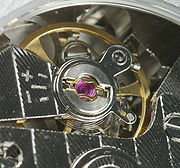
Incabloc shock protection system
Encyclopedia

Jewel bearing
A jewel bearing is a plain bearing in which a metal spindle turns in a jewel-lined pivot hole. The hole is typically shaped like a torus and is slightly larger than the shaft diameter. The jewel material is usually synthetic sapphire...
s that support the balance wheel
Balance wheel
The balance wheel is the timekeeping device used in mechanical watches and some clocks, analogous to the pendulum in a pendulum clock. It is a weighted wheel that rotates back and forth, being returned toward its center position by a spiral spring, the balance spring or hairspring...
in a mechanical watch
Watch
A watch is a small timepiece, typically worn either on the wrist or attached on a chain and carried in a pocket, with wristwatches being the most common type of watch used today. They evolved in the 17th century from spring powered clocks, which appeared in the 15th century. The first watches were...
, to protect the wheel's delicate pivots from damage in the event of physical shock
Shock (mechanics)
A mechanical or physical shock is a sudden acceleration or deceleration caused, for example, by impact, drop, kick, earthquake, or explosion. Shock is a transient physical excitation....
, such as if the watch is dropped. It was invented in 1934 by Swiss engineers Georges Braunschweig and Fritz Marti, at Universal Escapements, Ltd, Chaux-de-Fonds, Switzerland. It is currently manufactured by Incabloc, S.A. Similar systems are ETA's Etachoc, Kif, Seiko
Seiko
, more commonly known simply as Seiko , is a Japanese watch company.-History and ongoing developments:The company was founded in 1881, when Kintarō Hattori opened a watch and jewelry shop called in the Ginza area of Tokyo, Japan. Eleven years later, in 1892, he began to produce clocks under the...
's Diashock, and Citizen
Citizen Watch Co.
is the core company of a Japanese global corporate group based in Tokyo, Japan. The company was originally founded as Shokosha Watch Research Institute in 1918 and is currently known as the manufacturer of CINCOM precision lathe machine tools as well as CITIZEN watches. The trade name originated...
's Parashock.
The pivots and jewel bearings that support a watch balance wheel are fragile in comparison to the mass they must support, and without shock protection are the most likely part of the watch to be damaged under impact. Before the widespread use of shock protection devices like Incabloc, broken balance staffs were a major cause of watch repair service visits.
The Incabloc system uses a "lyre
Lyre
The lyre is a stringed musical instrument known for its use in Greek classical antiquity and later. The word comes from the Greek "λύρα" and the earliest reference to the word is the Mycenaean Greek ru-ra-ta-e, meaning "lyrists", written in Linear B syllabic script...
-shaped" spring to allow the delicate bearings to shift in their settings under impact, until a stronger shoulder of the staff contacts the strong metal endpiece, so that the pivots and bearings don't have to bear the force of the impact. When the impact is over, the springs guide the parts back to their original positions. The staff itself does not move relative to the jewel bearing, but the whole bearing is carried in a metal bushing that is free to move in the metal endpiece, under the control of the spring.Original Incabloc advert Some modern balance wheels use a simplified arrangement, where an enlarged jewel (taking advantage of the low cost of modern synthetic rubies) is free to move as its own mobile bushing.

